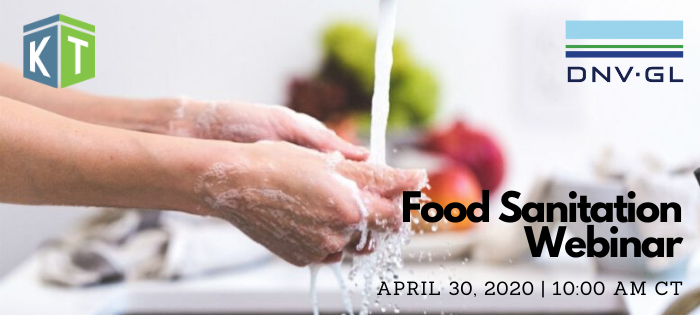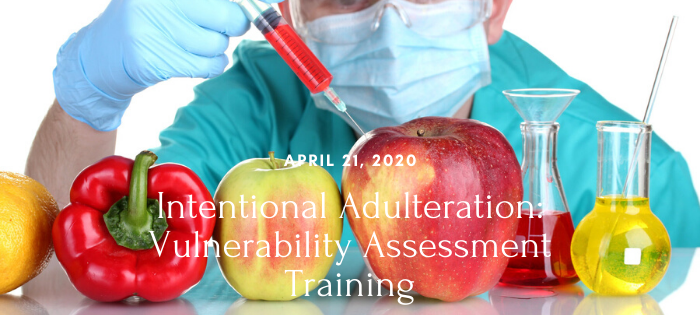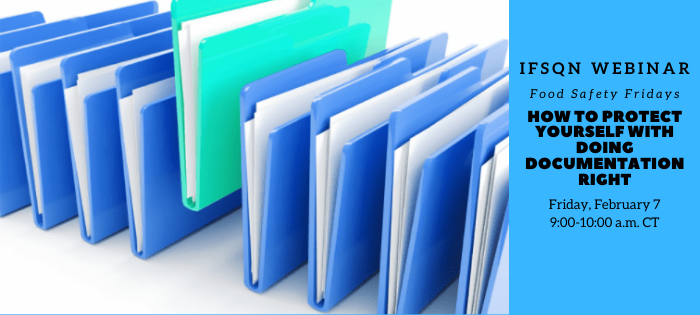
Comments: 4 Comments
Apr. 30 Webinar: Maintain Plant Sanitation Following Shutdown
Many food companies face challenges when it comes to sanitation and hygiene, particularly after periods of shutdown or emergency response when the company returns to “business as usual”. Join Kestrel Tellevate LLC (KTL) Principal Bill Bremer and DNV GL for a free webinar that will provide guidance to keep your company safe and in compliance.
Maintain Your Plant, Equipment & Personnel Sanitation Following Shutdown Periods
April 30, 2020 | 10:00 – 11:30 a.m. CT
Register Now!
This webinar will focus on sanitation and hygiene best practices for building, equipment, personnel areas, personnel, and employee welfare as it relates to startup for pre-operations following shutdown or emergency response periods. Each area will be described, along with the related sanitation/hygiene issues, concerns, possible impacts, risks, inspection, observation, and controls.
Learning Objectives
Topics covered in the webinar include the following:
- Various methods of sterilization, sanitation, and disinfection
- Potency in killing germs and unknowns of efficacy
- Applicability in manufacturing, processing, holding, and for various sizes of packaging
- Advantages and disadvantages of inspection types (e.g., visual, odor, physical state)
- Recommendations to achieve effective results with Environmental monitoring (EM) programs
- Considerations for expanded programs based on the re-start situation
- Documenting the sanitation processes
- Responding to unanticipated testing or observations

Employees Need Rules, Not Regulations
KTL recently announced our partnership with Martin Mantz Compliance Solutions (Martin Mantz), developer of the GEORG Compliance Management System® software. KTL is providing regulatory compliance expertise to the German-based company as it expands its offerings to clients with operations in the United States.
In this recent article, our partners at Martin Mantz discuss how Rudolph Logistics Group, an international logistics service provider from Germany, is using GEORG as a compliance solution to provide employees clear information in accordance with ISO standards on:
- Tasks – what they have to do
- Responsibilities for implementation – who needs to do it
- Date/time of completion – when it needs to be done
- Description of the way the task is to be performed – how the task must be fulfilled
The objective is to simplify requirements to the extent possible so employees can focus on tasks to be completed without needing to interpret complicated and extensive guidelines. Read more…

Comments: No Comments
KTL Announces Partnership with German Company Martin Mantz
KTL is pleased to announce our partnership with Martin Mantz Compliance Solutions (Martin Mantz), developer of the GEORG Compliance Management System® software. KTL is providing regulatory compliance expertise to the German-based company as it expands its offerings to clients with operations in the United States.
“Martin Mantz has created something unique with the GEORG software in that it simplifies and provides an interpretation of legal and technical requirements in a customer-specific database,” KTL Principal Lisa Langdon states. “KTL’s understanding of industrial operations, as well as U.S. legal and technical requirements (e.g., EPA, OSHA, FDA, ISO), allows us to translate these requirements into simple tasks in the GEORG system that employees can follow to help fulfill regulatory requirements.”
How GEORG Works
GEORG is used to make the requirements of standards and regulations comprehensible and transparent. KTL specializes in the practical mapping of legal requirements and audits. These audits allow KTL to create technical content for the GEORG system based on facility-specific applicability. We then work directly with the company to delegate the identified tasks. If there are revisions in the standards/regulations, KTL works in the system to ensure tasks are updated to meet regulatory requirements.
The benefits of this approach include:
- Effectiveness – All tasks are assigned, easily formulated, and regularly updated.
- Efficiency – The effort and expertise required to understand complicated regulations is reduced.
- Transparency – Responsibilities are clear and easily visible to all employees.
- Conformity – Compliance status within the system reflects the degree of fulfilment of the related requirements.
Faber-Castell Expands GEORG Implementation to U.S. Subsidiary
Faber-Castell Cosmetics, an internationally renowned Martin Mantz customer with worldwide operations, is already benefitting from the Martin Mantz-KTL partnership. After successful implementation of the GEORG software in their German facilities, Martin Mantz has worked with KTL to expand usage to Faber-Castell’s subsidiary in the U.S.
About Martin Mantz Compliance Solutions
Martin Mantz Compliance Solutions, based in Grosswallstadt and Leipzig, Germany, offers its contractual partners services in the area of legal organization (GEORG) of companies to avoid organizational negligence and compliance violations. This includes consulting and provision of the compliance software GEORG Compliance Management System®, implementation of the technical and legal modules, as well as construction and maintenance of the customer-specific database. https://www.martin-mantz.de/
About Kestrel Tellevate LLC
KTL is a multidisciplinary consulting firm that specializes in providing environmental, health, and safety (EHS) and food safety management and compliance consulting services to private and government clients. Our primary focus is to build strong, long-term client partnerships and provide tailored solutions to address regulatory requirements. KTL’s services include management system development and implementation, auditing and assessments, regulatory compliance assistance, information management solutions, and training. KTL is a Small Business Administration-registered company with headquarters in Madison, WI and Atlanta, GA and offices across the Midwest and Washington, D.C. www.kestreltellevate.com

Comments: No Comments
Food Intentional Adulteration: Vulnerability Assessment Training
Food Intentional Adulteration:
Vulnerability Assessment Training
April 21, 2020 | 8:30 am – 5:00 pm
Courtyard by Marriott – Chicago O’Hare
2950 S. River Road | Des Plaines, IL
Cost: $500
REGISTER NOW!
Background
On July, 26 2016, the final rule for Mitigation Strategies to Protect Food Against Intentional Adulteration was released as part of the Food Safety Modernization Act (FSMA). This rule defines the requirements for facilities manufacturing, processing, handling, packing, and storing food products to protect food against acts intended to cause wide-scale public harm to consumers.
The regulation requires all facilities handling food products to complete a vulnerability assessment for their processes. Based on results, facilities are then required to implement mitigation strategies against potential threats (e.g., terrorism, tampering, sabotage).
Training
Kestrel Tellevate LLC’s (KTL) Intentional Adulteration Vulnerability Assessment Training is a one-day course designed to train responsible Food Defense Qualified Individuals to understand the current requirements to protect against intentional adulteration.
This course will focus on the the vulnerability assessment approach, according to the FSMA regulation. The Food Defense Qualified Individual will learn strategies to:
- Implement the Food Defense Plan
- Perform the vulnerability assessment
- Define mitigation strategies
- Conduct periodic review of the Food Defense Plan
Participation in this course will help to ensure compliance with the requirements outlined in the Intentional Adulteration Rule to protect against food adulteration.
 Trainer
Trainer
KTL is pleased to welcome CSQA Foreign Affairs Manager Carlo Merlo as our instructor for this course. Carlo is a Lead Instructor for Intentional Adulteration Vulnerability Assessment.
REGISTER NOW!

Principles of Auditing
To ensure companies uphold standards (internal or external) and continuously improve performance, audits are critical. In short, there are three primary purposes of auditing:
- Verify conformance with the standard/requirement – Are we doing what the standard/requirement says we must do?
- Verify implementation of stated procedures – Are we following the steps in our documented procedures?
- Evaluate effectiveness – Are we accomplishing our goals and objectives?
For an audit to be effective, appropriate mechanics must be in place when it comes to planning, execution, and reporting.
PLANNING
As with most things, your execution will only be as good as your plan. All good audits must begin with planning. This involves everything from planning for your team, to planning out the scope of the audit, to planning all the associated logistics.
Auditors: Who Is on the Team?
Depending on the size and complexity of the audits, audit teams need to be selected. These individuals must be independent of the area being audited and trained in the basic elements of the facility’s management system and/or programs. Team members will be led by a trained auditor. The auditor’s responsibilities include the following:
- Comply with and communicate audit requirements
- Prepare working documents under the direction of the Lead Auditor
- Plan and carry out the assigned responsibilities within the scope of the audit
- Collect and analyze evidence to draw conclusions
- Document audit observations and findings
- Report audit results to Lead Auditor
- Retain and safeguard audit documents
- Cooperate with and support the Lead Auditor
- Assist in writing the report
As indicated above, one person on the team is typically designated the Lead Auditor. This individual will coordinate audit assignments and address any questions/concerns that may arise. Specifically, the Lead Auditor has the following responsibilities:
- Assigns team members specific management system/program elements, functions, or activities to audit
- Provides instructions on the audit procedure to follow
- Makes changes to work assignments, as necessary, to ensure the achievement of audit objectives
Audit Objectives, Scope, and Plans: What Are We Auditing?
The audit is all about:
- Conformance – auditing sections of the standard/requirements to determine if the system conforms
- Implementation – auditing work instructions to see if they are being followed
In determining the audit scope, it is importation to define what is to be audited (e.g., policy, planning, implementation, checking/corrective action, management review). If the organization has more than one physical location, the scope may outline what physical locations and/or organizational activities are to be audited (e.g., production lines or departments). These factors will ultimately also help determine the length of the audit.
Logistics: How Are We Going to Do This?
There are many things to factor into the audit from a logistical standpoint for it to go smoothly. Safety should always be of utmost concern. What precautions do auditors need to take? Is there any PPE that might be necessary? Do auditors need any special safety training introduction or training before conducting the audit? Consider the facility. Auditors need to understand the operation/activity being audited. In line with this, the auditor must also have an understanding of whether there is any equipment or special resources needed, ranging from technical support (e.g., tablets, smartphones) to lunch. Finally, it is important to make sure there are no conflicts of interest when it comes to the auditor and the facility that is being audited.
EXECUTION
Once planned appropriately, audits should be conducted according to the program elements. Interviews and objectives evidence will both provide the support needed to conduct a valid audit.
Program Elements
The auditor must know in advance which elements are being covered in an audit so he/she can:
- Control the pace of the audit.
- Guide the course of the audit.
That being said, additional audit activities should not be restricted if other issues arise.
Auditing should only be done against current controlled work instructions or procedures related to the program elements. Procedures that are being used in the field must be verified. Historical and/or uncontrolled procedures should not be used.
Auditors must remember that they are creating a record. Notes should include statements, document numbers, identifiers (e.g., department, area), positions. Common pitfalls to be avoided in taking notes include abbreviations, no location identifier for observations, no document references, illegible, pejorative, cryptic. These things all impact the credibility of the audit.
Interviews
The goal of an interview in the audit is to obtain valid information. However, how questions are asked will impact the answer. Auditors must prepare and know what questions need to be asked and how to ask them in advance of the audit. Creating an atmosphere of trust and open communication is key to getting open and honest responses. Remember, the goal is to audit the system, not the interviewee.
The following are good rules of thumb for conducting effective audit interviews:
- Direct questions to the person who does the job, not to the supervisor.
- Never talk down to anyone.
- Speak the person’s language.
- Speak clearly and carefully.
- LISTEN!
- Use who, what, where, when and why in your questioning vs. can or does.
Objective Evidence
Objective evidence provides verifiable information, records, or statements of fact. This is vital in any audit report. Objective evidence can be based on any of the following:
- Interviews
- Examination of documents
- Observation of activities and conditions
- Results of measurements
- Tests
- Other means within the scope of the audit
Evidence should be firsthand evidence based on witnessed fact, not supposition, presumption, hearsay, rumor, or conjecture. It can be qualitative or quantitative, but it should be repeatable.
REPORTING
Findings form the basis of the report. Findings can be classified in one of two ways:
- Nonconformance is the observed absence of or lapse in a required procedure or the total breakdown of a procedure that can cause a negative impact on the organization’s environmental performance. These can fall into a few categories:
- Does not meet the requirements of the standard. This may include issues identified with records, procedures, work instructions, and use of controlled documents.
- Is not fully implemented. Most commonly, these implementation nonconformances may relate to training, communication, and documentation.
- Is improperly implemented. This is often demonstrated by worker lack of understanding, improper implementation of written work instruction, or missing stated required deadlines.
- Opportunity for improvement is just that—an opportunity to improve management to either reduce impacts, minimize legal requirements, prevent future nonconformances, or improve business performance.
The following examples and tips can serve as guidelines for writing useful and more concrete findings that will the company to identify opportunities for improvement:
- Do not overstate conclusions.
- Poor: The procedure for handling spent light bulbs is being ignored.
- Better: Three spent fluorescent bulbs were found in the general trash.
- State the problem clearly and exactly.
- Poor: Instruments are not being calibrated.
- Better: The sampling and analytical instruments in the wastewater treatment plant are not calibrated.
- Avoid generalities.
- Poor: The area’s empty drum management process is inadequate.
- Better: The hi-lo driver in the area handling empty drums was not trained on hazardous material handling.
- Communicate the extent of the problem fully.
- Poor: All cardboard in the catalytic converter area is being sent to the compactor.
- Better: None of the cardboard in the catalytic converter area was being stored and/or evaluated for reuse as dunnage.
- Do not focus on criticisms of individuals.
- Poor: Jim Jones had no understanding of the safety policy.
- Better: Discussions with several employees indicated that the safety policy was not fully understood.
- Give specific references.
- Poor: Hazardous waste area inspections have not been conducted.
- Better: Weekly hazardous waste storage area inspections (VMEWP-008) have not been conducted since June 2002.
- Avoid indirect expressions.
- Poor: There were occasions when the reports were not filed on time. It appears the air monitoring equipment is not calibrated.
- Better: Reports were filed late on ten occasions in 2002. There were no records of air monitoring equipment calibrations for 2001 or 2002.
Audits are a skilled activity. They provide the basis for assessment of conformance and, correspondingly, company actions to improve performance. For audits to be valuable, however, the audit process must be consistent and controlled. Clearly and correctly documented nonconformances lead to appropriate corrective actions—the mechanism for translating audits into improvements.

Comments: No Comments
Webinar: Protect Yourself by Doing Documentation Right
Join Kestrel Tellevate, along with DNV GL, for a FREE IFSQN Food Safety Friday webinar on How to Protect Yourself with Doing Documentation Right.
Food Safety Friday Webinar
How to Protect Yourself with Doing Documentation Right
Friday, February 7, 2020
9:00 a.m. – 10:00 a.m. CT
REGISTER NOW!
KTL Principal Bill Bremer will discuss the legal aspects of preparing food safety and quality documentation in the right way from the start. The webinar will cover the proper progression of developing documented programs correctly and the related information management requirements (i.e. verification, validation, back-up and systems-based document control).

4 Steps to Reporting Audit Results
The audit report communicates the information, findings and opinions derived from the audit. The report communicates either acceptability of the current status of the management system or reports non-conformances that need corrective action. The following outlines the suggested steps for reporting audit results.
Step 1. Assess the Status of Current Internal Controls
One of the auditor’s main responsibilities is to evaluate whether the current internal controls that govern the management system are adequate. Do the audits:
- Highlight areas of concern or hazards that may be a failure waiting to happen?
- Focus attention of the 20% of the factors that cause 80% of the problems?
- Help to eliminate ineffective controls or make existing controls better?
- Aid in the detection and prevention of deficiencies or non-conformances?
- Look through and investigate possible “homeblindness”?
- Verify the management system links are supportive and feed each other information to assure continual improvement?
The auditors must constantly challenge the status quo and push the management system forward beyond its comfort level.
Step 2. Prepare Audit Report
Most facilities use a formal audit report system. The audit report format is prescribed and followed by the auditor. The auditor typically states:
- Date and time of audit
- Department audited
- Management system clauses audited to
- Personnel interviewed
- Documents reviewed
- Summary of findings
- Conformance or non-conformance determination
Step 3. Discuss Audit Findings
The lead auditor will then take the completed audit report and review the contents with the affected department head. Upon acceptance by the department head, the final audit report should then be signed by the department head verifying acceptance and responsibility for any change(s) required.
Step 4. Determine Plan of Action
The entire reason for conducting internal management system audits is to verify conformance and continually improve on the management system. Therefore, it is extremely important that all identified non-conformances are corrected in a timely manner.
Some companies place all audited non-conformances into their corrective/preventive action process for tracking purposes. Others place only critical non-conformances into the corrective/preventive action process. Regardless of the mechanics of tracking the identified audited non-conformances, it is imperative that corrective action is taken.
Once the corrective action is in place, the auditors should review the actions taken and verify the root cause was identified properly and resolved. An accept or reject decision can then be rendered for the change action.
If acceptable, no further action is required, and the issue is considered resolved. If unacceptable, the department head must complete a new root cause analysis, develop a new action plan, and put the new action plan into place. The auditors will now review the new action plan and make a determination of acceptance or rejection.
Audit Team Members
It is advisable to rotate your internal management system audit team members. This will allow for fresh perspective and a new set of eyes to look at the management system. This serves many purposes:
- Gives a specific timeframe of responsibly for those thinking of enlisting as an auditor
- Allows for gradual increase of responsibility over time; new auditors learn and perform audits, older auditors become mentors for the new auditors, graduates leave program and are viewed by company personnel as “knowledge experts” on the management system
- Allows for fresh perspective on auditing
- Trains numerous employees on the management system
- Reinforces the concept of continuous improvement
Are You Prepared?
Use your answers to the questions below to evaluate your preparation for reporting audit results.
- Has the auditor evaluated the current internal controls for suitability, adequacy, and effectiveness?
- Does the auditor have hard copy evidence of conformance and/or non-conformance?
- Have all questions prepared prior to the audit been satisfactorily answered and explained?
- Is the audit report clear, concise, and informative?
- Does the department head agree or disagree with the findings?
- Are all identified non-conformances tracked and resolved in a timely manner?
- Based on audit non-conformances, are procedures and work instructions being changed and improved?
- Do employees understand the management system is being audited, not the employee?
- Is change readily accepted by company personnel?

Comments: No Comments
Webinar: Best Practices for Aligning FSMA with GFSI
Join Kestrel Tellevate’s Bill Bremer for a free SafetyChain
Beyond Compliance Webinar this December.
“Aligning FSMA with GFSI Requirements: Best Practices for 2020”
Wednesday, December 11, 2019
10 am PST/Noon CST/1 pm EST
REGISTER NOW!
For FDA/FSMA-regulated food and beverage manufacturers who are also GFSI-certified, managing two or more sets of food safety requirements is not only complicated, it’s nearly impossible. Combining them into one unified program under a single framework would be far easier, helping to ensure all requirements are met and that nothing falls through the cracks.
But, conforming GFSI requirements to FSMA requires an advanced understanding of their similarities and differences. To complicate things, FSMA deadlines are a moving target. In 2019 alone, there were many changes to FSMA, including new requirements for FSVP, sanitation, environmental monitoring, food fraud, and food defense, in addition to the expansion of inspections. How will food safety leaders align and manage the differences between FSMA and GFSI in 2020 and make sure all requirements are met?
In this training webinar, industry experts from KTL will share best practices for incorporating and managing dual regulatory and non-regulatory requirements successfully into your GFSI scheme.
In this training you’ll learn:
- Key differences between FDA-FSMA and GFSI, including supplier compliance requirements
- Areas of key FSMA/GFSI overlap: hazard analysis, preventive controls, monitoring procedures, corrective actions, verification and validation, and customer complaint response
- Strategies for managing documents, data, and records that are shared by both systems
- Tips for conforming GFSI to FSMA requirements, including GFSI schemes and codes
- Ways to handle FSMA non-conformances in your GFSI audit
- Bonus insights: advice for managing your GFSI auditors

Comments: 1 Comment
Compliance & Commissioning for Food-Grade Products
All materials that are part of the food supply chain, including food packaging and contact materials, can significantly influence food safety. Inadequate packaging can fail to protect food properly or allow for contamination or adulteration. Producing safe food demands food safety management and compliance from all who contribute to the final food packaging and contact materials—those supplying materials, making the packaging, manufacturing food contact materials, and distributing the final packaged products.
Setting the Standard
Under the Global Food Safety Initiative (GFSI) standards, major schemes (e.g., IFS PACsecure, the BRC Global Standard for Packaging, SQF Packaging, and FSSC 22000) provide guidance for the producers of packaging materials to ensure the safety and quality of food and non-food products.
The GFSI standards are described as different but equal. It is important that companies determine the best fit of the GFSI options for their own company requirements. All of the standards help manufacturers, packers/fillers, and retailers demonstrate that every reasonable measure has been taken to avoid a food safety incident. Qualified legal reviews have shown that these GFSI benchmarked standards also meet nearly all of the food safety requirements of FDA/FSMA.
The GFSI standards address the requirements to assure food safety by applying the Hazard Analysis and Critical Control Points (HACCP) and Good Manufacturing Practice (GMP) principles specific to food packaging risk and this sector of the food industry. The standards help manufacturers take responsibility by establishing a recognized Food Safety Management System (FSMS).
Each food packaging standard follows a defined documentation program for GFSI certification, and may fit specific packaging applications and food risk differently. As a general example, the FSSC 22000 certification scheme uses ISO 22000 and PAS 223 to identify the requirements for certification and to define a set of food safety requirements, as listed in sections 4-8 of the standard (see table below).
| 4. Food Safety System Requirements | 4.1. Establish an FSMS
4.2. Document your FSMS |
| 5. Food Safety Management Requirements
|
5.1. Demonstrate a commitment to food safety
5.2. Establish your food safety policy 5.3. Plan your FSMS 5.4. Clarify your FSMS responsibilities and authorities 5.5. Appoint a food safety team leader 5.6. Establish your communications 5.7. Develop emergency response procedures 5.8. Carry out FSMS management reviews |
| 6. Food Safety Resource Requirements | 6.1. Provide adequate FSMS resources
6.2. Provide adequate human resources 6.3. Provide adequate infrastructure 6.4. Provide adequate work environment |
| 7. Food Safety Realization Requirements
|
7.1. Manage the realization of safe products
7.2. Establish your prerequisite programs (PRPs) 7.3. Get ready to do a hazard analysis 7.4. Perform your organization’s hazard analysis 7.5. Establish your operational PRPs 7.6. Establish your HACCP plan 7.7. Update preliminary documents and programs 7.8. Plan and perform your verification activities 7.9. Establish a product traceability system 7.10. Control your nonconforming products |
| 8. Food Safety Confirmation Requirements
|
8.1. Confirm and improve food safety methods
8.2. Validate food safety control measures 8.3. Control your monitoring & measuring methods 8.4. Verify your FSMS 8.5. Improve your FSMS |
Preparing for Certification
Taking measures upfront to adhere to food safety standards helps assure that food packaging will meet in-use demands and regulatory requirements so that the food contents can be enjoyed safely. To prepare for certification, companies should:
- Identify regulatory requirements, which may include commissioning of plant and equipment to confirm compliance with food safety requirements
- Set clear target dates for assessment and implementation
- Establish an informed and thorough materials evaluation process
- Identify and document food safety hazards and relevant control measures (HACCP/GMP)
- Identify applicable GMPs (e.g., pest control, equipment & building maintenance, housekeeping & cleaning)
- Establish a robust FSMS that aligns with existing management systems (i.e., quality, environmental, health & safety)
- Implement any needed structural improvements
- Institute ongoing material and packaging testing protocols, as well as strict handling and use requirements
Case Study: Food-Grade Paper Mill
Kestrel has been involved with a number of paper and packaging facilities considering expanding production operations to manufacture food-grade product that meets GFSI, FSSC 2200, GMP, HACCP, and customer requirements. The following provides an example of how a Kentucky-based paper mill commissioned its site to manufacture paper products to meet the needs of food customers nationwide.
Phase 1: HACCP/GMP Compliance Analysis
Due to the recent changes in regulatory and certification requirements, this paper mill needed to be confirmed or commissioned as food-material compliant to continue its food-grade materials manufacturing. Building on its existing management system documentation, originally designed and certified to ISO 9001, the mill determined that it would comply with FDA food contact paper requirements and sought alignment with the GFSI FSSC 22000 standard.
Kestrel conducted a preliminary GMP/HACCP certification analysis to provide a third-party audit report on the mill’s compliance to regulatory and industry standards. The desktop, physical site, and process reviews included analysis of the following:
- Site HACCP program
- Risk analysis assessment
- GMP requirements under FDA
- Supplier program and receipt of goods
- Customer requirements and release of goods
- CAPA management
- Food safety objectives/policy
Based on this assessment, Kestrel established a project workplan and estimated timeline to develop and implement a food safety management program for both FDA and GFSI FSSC 22000 certification requirements.
Phase 2: GMP/HACCP FSMS
The mill proceeded with establishing the required programs for compliance to regulatory and industry standards for the manufacture of food-grade product meeting the processing requirements under GMP and HACCP. Specific project goals for this phase included:
- Designing and implementing a sustainable and compliant FSMS
- Developing a system that fully complies with all the FDA and industry (GFSI/HACCP) programs, procedures, and metrics
- Using a design and implementation process that draws from existing business/management systems and documentation
- Using a process that actively engages the workforce in the design/development, implementation, and ongoing improvement activities of the FSMS to create a participative food-safe packaging culture
- Using a scalable design and implementation process that is responsive to the company’s resources
Kestrel began this phase of the project by focusing on foundational management system elements and working stepwise through the GMP and HACCP programs. Project tasks included:
- Completing food safe packaging compliance register
- Conducting physical review
- Developing HACCP/preventive controls plan
- Creating GMP requirements list
- Developing food safety plan policies/procedures
- Determining second level procedures and work instructions
- Developing/providing training modules
- Conducting internal audits
- Starting management reviews
- Commencing program integrity audits and status updates
- Integrating with current corrective actions and management processes
- Starting FSSC certification process (staged)
Kestrel’s most recent review and assessment of the mill’s management systems and approaches to food safety standards indicate that the overall business integrity and compliance is at the highest level in respect to food safety packaging standards. A legal review has confirmed that the process and developed programs also meet food safety legal requirements.
Benefits
The flexible packaging industry has experienced rapid growth. Ongoing innovation has led to more new materials being used, growth in packaging formats, extreme in-use conditions, and increasingly more stringent FDA regulations and food safety standards. Commissioning plants for food safety is vital to operating within the food industry.
A company’s achievement as a reliable supplier is linked to its capability to provide safe products. In addition, adhering to food safety standards:
- Allows manufacturers to report on their status to key stakeholders (e.g., food retailers, customers)
- Covers areas of hygiene and product safety throughout the packaging industry
- Helps ensure that suppliers are also following good hygiene practices to complete the due diligence chain
- Ensures that a sustainable quality and product safety system is established and continually improved

Top 5 Critical Factors for Value-Added Auditing
Auditing is a management tool that can be used to evaluate and monitor the internal performance and compliance of your company with regulations and standards. An audit can also be used to determine the overall effectiveness of an existing system within your company.
How do you incorporate compliance auditing best practices to help maximize compliance, efficiency, and value of your audit? Here are five critical factors for value-added audits.
1. Goal Aligned with Business Strategy
There are many reasons why companies conduct audits:
- Support commitment to compliance
- Avoid penalties
- Meet management system requirements
- Meet corporate or customer mandates
- Support acquisition or divestiture
- Assess organizational structure and competency
- Identify cost saving and pollution prevention opportunities
- Determine alignment with strategic direction
It is vital to define and understand the goal of your compliance audit program before beginning the audit process. Establishing goals enables recognition of broader issues and can lead to long-term preventive programs. Not establishing a clear, concise goal can lead to a waste of resources.
Audit goals and objectives should be nested within the company business goals, key performance objectives, and values. An example of a goal might be to effectively measure environmental compliance while maintaining a reasonable return on investment.
Once the goal is established, it is important to communicate it across all functions of the organization to get company-wide support. Performance measurements should also be communicated and widely understood.
2. Management Buy-in
The audit program must have upper management support to be successful. Management must exhibit top-down expectations for program excellence, view audits as a tool to drive continuous improvement, and work to imbed audits within other improvement processes. Equally important, management must not use audit results to take punitive action against any person or department.
3. Documented Audit Program Systematically Applied
Describe and document the audit process for consistent, efficient, effective, and reliable application. Audit procedures should be tailored to the specific facility/operation being audited. A documented program will include the following:
- Scope. The scope discusses what areas/media/timeframe will be audited. The scope of the audit may be limited initially to what is manageable and can be done very well, thereby producing performance improvement and a wider understanding and acceptance of objectives. It may also be limited by identifying certain procedural or regulatory shifts and changes. As the program is developed and matures (e.g., management systems, company policy, operational integration), it can be expanded and, eventually, shift over time toward systems in place, prevention, efficiency, and best practices. It is important at the scoping stage to address your timeline. Audits should be scoped to make sure you get them done but also to make sure you have audited all compliance areas in an identified timeframe.
- Criteria. Compliance with requirements will clearly be covered in an audit, but what about other opportunities for improvement (e.g., pollution prevention, energy savings, carbon reduction)? All facilities need to be covered at the appropriate level, with emphasis based on potential compliance and business risks. Assess the program strengths, redundancy, integration within the organization, and alignment with the program goal. Develop specific and targeted protocols that are tailored to operational characteristics and based on applicable regulations and requirements for the facility. As protocols are updated, the ability to evaluate continuous improvement trends must be maintained.
- Auditor training (i.e., competency, bias). A significant portion of the audit program should be conducted by knowledgeable auditors (e.g., independent insiders, third parties, or a combination thereof) with clear independence from the operations being audited and from the direct chain of command. For organizational learning and to leverage compliance standards across facilities, it is good practice to vary at least one audit team member for each audit. Companies often enlist personnel from different facilities and with different expertise to audit other facilities. Periodic third-party audits further bring outside perspective and reduce tendencies toward “home-blindness”.
Training should be done throughout the entire organization, across all levels:
+ Auditors are trained on both technical matters and program procedures.
+ Management is trained on the overall program design, purpose, business impacts of findings, responsibilities, corrections, and improvements.
+ Line operations are trained on compliance procedures and company policy/systems.
Consider having auditor training conducted by an outside source to teach people how to decide what to audit and follow a trail. It can also work well to train internal auditors by having them audit alongside an experienced 3rd party.
- Audit conduct (i.e., positive approach). A positive approach and rationale for the audit must be embraced. Management establishes this tone and sets the expectation for cooperation among all employees. Communication before, during, and after the audit is vital in keeping things positive. It is important to stress the following:
- Auditor interviews are evaluating systems, not personal behaviors.
- The audit is an effective tool to improve performances.
- Results will not be used punitively.
- Audit reporting. Information from auditing (e.g., findings, patterns, trends, comparisons) and the status of corrective actions often are reported on compliance dashboards for management review. Audit reports should be issued in a predictable and timely manner. It is desirable to orient the audit program toward organizational learning and continual improvement, rather than a “gotcha” philosophy. “Open book” approaches help learning by letting facility managers know in advance what the audit protocols are and how the audits will be conducted. Documentation is essential, and reporting should always align with program goals and follow legal guidance. There is variability in what gets reported and how based on the company’s objects. For example:
- Findings only vs. opportunities for improvement and best management practices?
- Spreadsheet vs. long format report?
- Scoring vs. prioritization of findings (beware of the unintended consequences of scores!)?
- Recommendations for corrective actions included or left for separate discussion?
- Corrective and preventive action. Corrective actions require corporate review, top management-level attention, and management accountability for timely completion. A robust root cause analysis helps ensure not just correction/containment of the existing issue, but also preventive action to assure controls are in place to prevent the event from recurring. For example, if a drum is labeled incorrectly, the corrective action is to relabel that drum. A robust plan should be to also look for other drums that might be labeled incorrectly and to add and communicate an effective preventive action (e.g., training or posting signs showing a correctly labeled drum).
- Follow-up and frequency. Address repeat findings. Identify patterns and seek root cause analysis and sustainable corrections. Communications with management should be done routinely to discuss status, needs, performance, program improvements, and business impacts. Those accountable for performance need to be provided information as close to “real time” as possible. There are several levels of audit frequency, depending on the type of audit:
- Frequent: Operational (e.g., inspections, housekeeping, maintenance) – done as part of routine day-to-day operational responsibilities
- Periodic: Compliance, systems, actions/projects – conducted annually/semi-annually
- As needed: For issue follow-up
- Infrequent: Comprehensive, independent – conducted every three to four years
4. Robust Corrective Action Program
As mentioned above, corrective actions are a must. If there is no commitment to correction, there is no reason to audit. A robust root cause analysis is essential. This should be a formal, yet flexible, approach. There should be no band-aids. Mistake-proof corrections and include metrics where possible. In the drum example given above, a more robust corrective action program would look at the root cause: Why was the drum mislabeled? Did the person know to label it? If so, why didn’t they do it?
The correction itself is key to the success of the audit program. Establish the expected timeframe for correction (including addressing preventive action). Establish an escalation process for delayed corrections. Corrective actions should be reviewed regularly by upper management using the existing operations review process. There must also be a process for verification that the correction has been made; the next audit cycle may not be sufficient.
Note also that addressing opportunities for improvement, not just non-compliance findings, may increase the return on investment associated with conducting an audit.
5. Sharing of Findings and Best Practices
Audit results should be communicated to increase awareness and minimize repeat findings. Even if conducted under privilege, best practices and corrections can and should still be shared. Celebrate the positives and creative solutions. Stress the value of the audit program, always providing metrics and cost avoidance examples when possible. Inventory best practices and share/transfer them as part of audit program results. Use best-in-class facilities as models and “problem sites” for improvement planning and training.
Value-Added Audit
An audit can provide much additional value and return on organization if it is planned and managed effectively. This includes doing the following:
- Align program goal with business strategy to secure top-down buy-in
- Expand criteria beyond compliance
- Gain goodwill through positive approach
- Document program and results
- Monitor for timely, effective corrective action
- Share opportunities for improvement
